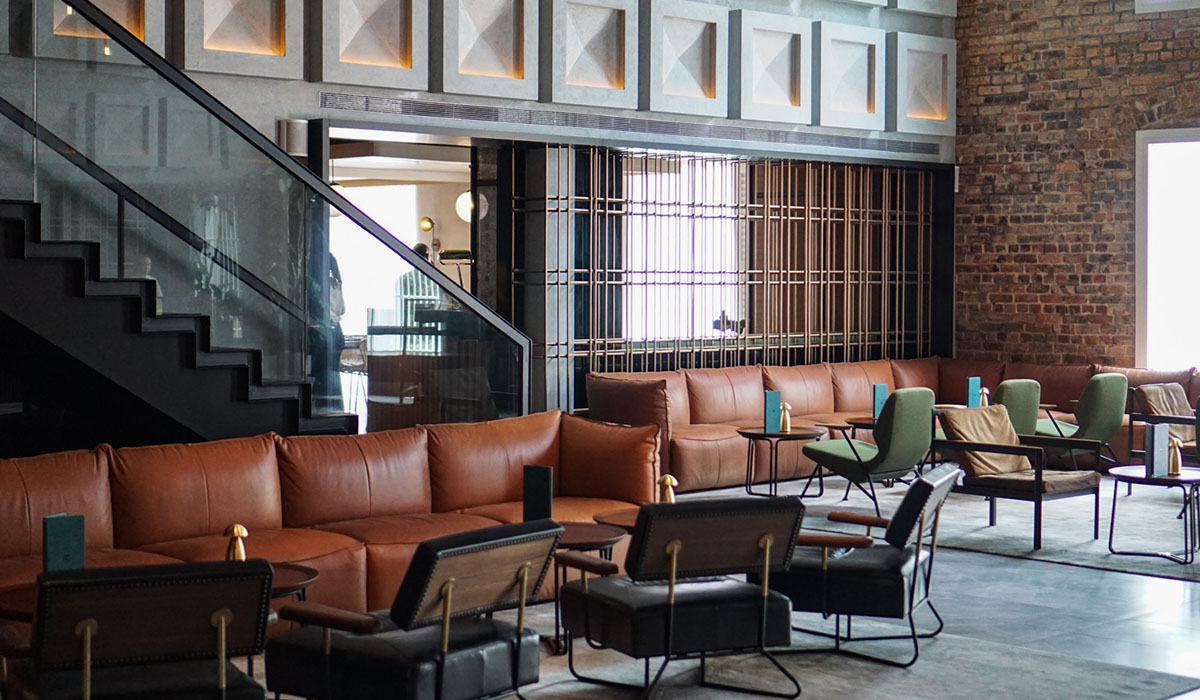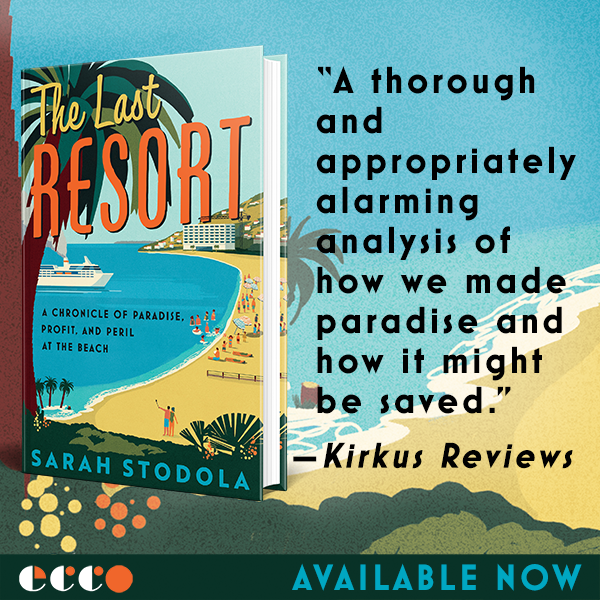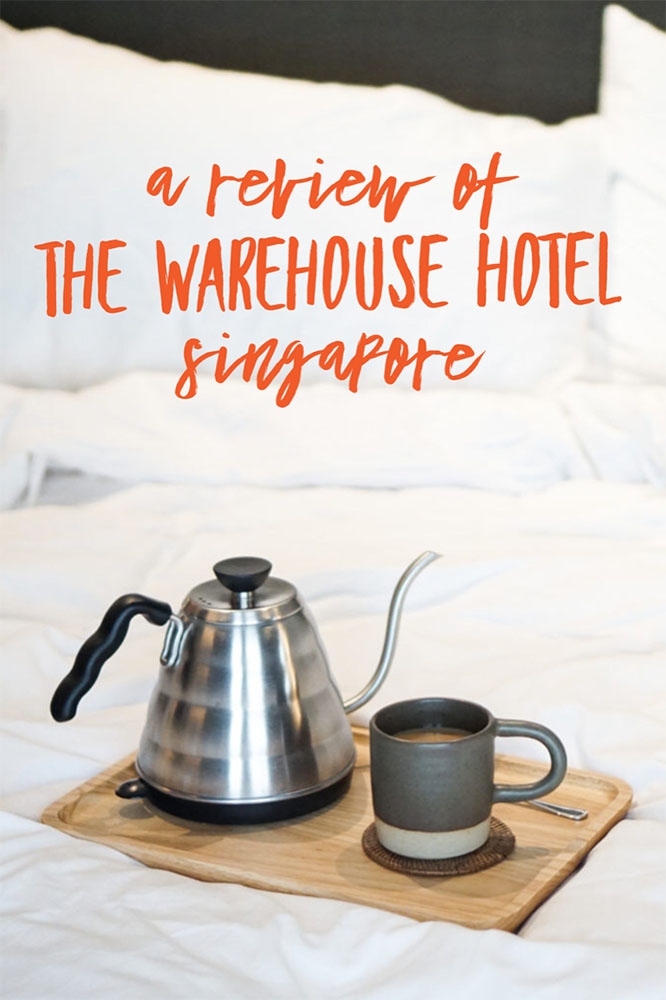One of the best ways to gauge the quality of a hotel comes when it’s time to leave it. If you’re as stricken over the prospect as I was on my last night at the Warehouse Hotel in Singapore, chances are you’ve landed on something special. I’d grown accustomed, it turned out, to the many ways in which this hotel seduces you, and to the dependable comfort that made the sexiness all the easier to enjoy.
The Warehouse opened in January 2017 in an 1895 spice warehouse, or godown as they’re known locally, on the Singapore River in the Robertson Quay neighborhood. Reimagined as a historic, hip boutique hotel in a city where accommodation in glassy high rises tends to rule the day, no detail here is overlooked, and each one is uniquely interesting.
On arrival, guests approach a white three-story building. That modest height is put to spectacular use in the lobby, which also houses the bar. Molded concrete blocks stretch up to the roof, while light fixtures built to resemble the pulleys that once lifted spices to the top of the warehouse hang dramatically from it. Three distinct seating areas, plus the bar and reception, provide the space with an intimacy; the furniture doesn’t exactly eschew Midcentury trends, but it incorporates a warmth, and a general cushiness that era sometimes lacks.
We took to ending each day with a drink in the lobby bar, and in addition to well-done original cocktails, the bartender made a top-notch Old Fashioned. These were some of the only satisfactorily stiff drinks I had in Singapore, making them all the more appealing. The space perpetually felt the right amount of crowded; always a buzz, but never trouble getting a good seat.
And then on to our room, one of only 37 total, no two the same. We checked in to a River View Loft, a high-ceilinged space (those beams are original) uniquely equipped to handle our 12-hour-time-difference jetlag, providing a soft landing into those waking hours at 2am or 4:30am. The king bed couldn’t have been more comfortable, and the room’s many lighting sources catered to the spectrum of sleep and wakefulness. The décor doesn’t embrace color, but the muted tones remain interesting thanks to variety in texture: Marble, concrete (or the appearance of it, in the wall panels), copper, wood, tasteful mirrors, thick curtains and a lavish area rug assemble themselves in perfect harmony.
Our room opened directly onto a landing overlooking the lobby, a floorplan that made it feel like an extension of our living space, like the lobby was the living room, and I felt welcome to potter down to hang out at any time of day or night.
[Review continues after the photo gallery]
In terms of daytime functionality, the room also exceled. The desk was comfortable, the great Bang & Olufsen speaker connected to my phone via Bluetooth. The TV was a good size, but managed not to mess with the flow of the room. For me the only missing pieces were an armchair—it would have been nice to laze around somewhere aside from the bed, even though who am I kidding, I would have spent most of my time in that bed anyway—and a closet to shove our emptied suitcases into.
The in-room coffee situation is next level, with individual pour-over pouches of locally roasted beans and real half and half to go with them. The mugs come from Mud Rock, a Singapore ceramics studio. I could have sat there half on, half in the bed all day sipping my brew out of those mugs and staring at the occasional boat drift past the foot of it through the window.
In this open plan room, the bathroom blends into the greater space. A deep bathtub just behind the bed’s headboard serves as the anchor for the surrounding sink, toilet room, and shower stall. It’s a weird layout that works well, and like in the rest of the hotel, the magic is in the details.
The two bathmats, usually an afterthought even in the nicest hotels, are large, plush, perfectly white treats for the feet. The shower is a masterpiece, starting with the generous proportions of the stall itself. Add to that the rain shower, the flat shelf, the glorious hotness and water pressure, and the environmentally friendly Ashley & Co. toiletries in large bottles with pumps, instead of small individual bottles.
Singapore is not a great walking city, but the pedestrian-only riverside just outside the hotel’s doors bucks that fact—it’s great for a stroll to one of the many restaurants and bars lining the water. There’s no subway nearby, so getting to Chinatown or Marina Bay requires a bus or car. Thankfully, Ubers are remarkably cheap, and became my primary mode of transportation. A ride home from the National Museum, for example—taken after a heat-stroke-inducing walk to get there—cost about US $4; one to Chinatown about US $5.
Atop a two-story metal platform next to the main building lies perhaps the Warehouse’s most singular amenity, the pool. An infinity pool on steroids, its walls are built entirely of glass on three sides, allowing those not in the pool, including people on street looking up, to see into it. The resulting visual trickery is mesmerizing. The hotel is small enough that we rarely had to share the pool—we took two cans of beer up there one night and had it to ourselves for an hour. Please, if you stay at this hotel, do not miss out on the pool.
Breakfast is served in the restaurant off the lobby, Po, and it’s a wonder. Exotic fruits, flaky pastries, charcuterie and yogurt are available buffet-style, while guests can also choose a cooked item from the menu. We tried them all, and all were good, but the Bak Kut Tek blew our minds (I had mine without the pork ribs). (I didn’t eat dinner in Po—as a vegetarian, I wouldn’t have had much to choose from on the menu.)
I was shattered to leave the Warehouse Hotel, a place that triumphs at everything it tries without succumbing to pretension. It’s not quite the first boutique hotel to open in Singapore, but the Warehouse Hotel is the one that will put boutique hotels in Singapore on the map.







